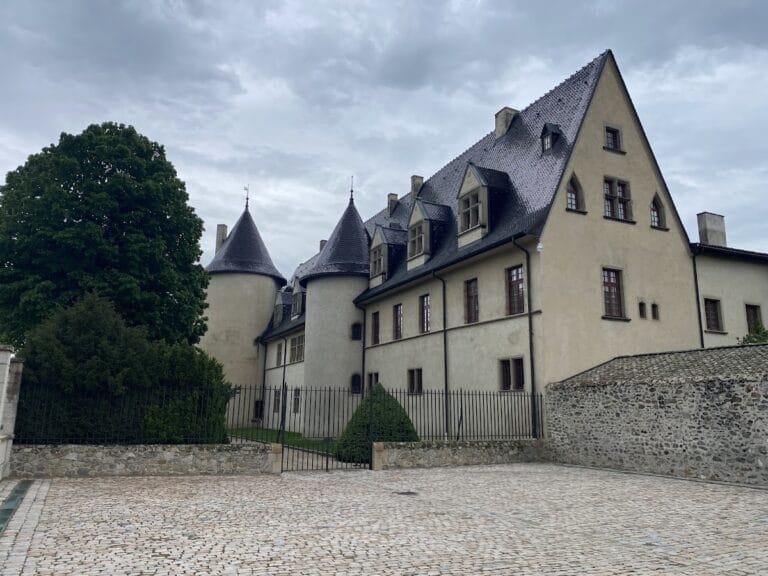Château de Jarcieu: A Medieval Castle in Jarcieu, France
Visitor Information
Google Rating: 3.8
Popularity: Very Low
Google Maps: View on Google Maps
Official Website: www.chateau-de-jarcieu.com
Country: France
Civilization: Unclassified
Remains: Military
History
The Château de Jarcieu stands in the village of Jarcieu, France, and was established by medieval builders during the late Middle Ages, likely in the 15th century. While an earlier castle might have existed on the site, the current structure reflects developments from this later period.
In the late 15th century, the castle served as a residence and administrative center for regional nobility. Jacques de Miolans, a knight and governor of Dauphiné, was closely associated with the château, signing official documents there until his death in 1496. During this time, the castle also briefly hosted King Charles VIII, indicating its importance in local governance and hospitality.
The château gained further prominence in the 16th century, notably on August 15, 1564, when King Charles IX, accompanied by his mother Catherine de Médicis and the future kings Henri III and Henri IV, stayed overnight while escaping a plague outbreak in Roussillon. This event reflects the castle’s role as a refuge for royalty during times of crisis.
During the turbulent period of the French Wars of Religion, the château was linked to Jacques de Saluces de Miolans, a Protestant military leader and lord of both Cardé and Jarcieu. Later, under Henri IV’s reign, Jacques Mitte-Miolans, who held the titles of baron of Jarcieu and Count of Anjou, served high-ranking positions including state counselor and lieutenant-governor overseeing the Lyonnais, Forez, and Beaujolais regions.
In the 17th century, Louis XIII elevated the barony of Jarcieu by uniting it with that of Anjou and transforming Anjou into a county. Under the reigns of Louis XIII and his successor Louis XIV, Melchior Mitte de Chevrières, baron of Jarcieu, received the titles of Count of Anjou and first baron of Lyonnais and Savoy. He held significant military and governmental roles as a state minister, lieutenant-general of royal armies, and governor of Provence.
Ownership passed in 1669 to Alexandre Falcoz de la Blache, whose family maintained possession through the late 18th century. The castle changed hands during the 19th century, when the Rostaing de la Valuze family became its owners before it transferred to other families in later years.
Today, the château preserves its legacy by housing fine collections related to its history and culture, continuing the story of its long and varied past.
Remains
The Château de Jarcieu showcases a layout characteristic of late medieval fortified residences, constructed mainly with traditional regional materials. The main structure features walls built from molasse stone, a soft sedimentary rock common in the area, alongside river pebbles known locally as galet. These elements combine to create solid masonry typical of the period. The outbuildings differ in their use of rammed earth, or pisé, a building technique involving compressed layers of soil, which was used exclusively for these secondary structures.
A notable feature on the castle’s south-facing façade is an 18th-century sundial measuring approximately 1.6 meters square. This sundial is coated with lime plaster over a bed of rolled pebbles, giving it a distinctive textured appearance. Above the dial, the inscription “IN RECTO DECUS” is displayed, which translates from Latin as “honor acquired in a straight line,” reflecting an ideal of integrity or upright conduct. The sundial remains visible in situ, serving as a historical marker of the castle’s use and updates during the early modern period.
The château is situated near the heart of Jarcieu village, specifically along Rue Saint-Sulpice, integrating its grounds with the local settlement. Within the castle’s dependencies, a museum known as the Musée de la Faïence Fine holds an extensive collection of fine faience ceramics. These objects include various types of elaborately decorated household pieces made from tin-glazed earthenware, such as moustache cups designed with special features for gentlemen, puzzle and rebus plates bearing visual word games, shaving dishes, small toy tea sets, and distinctively crafted money boxes. The preservation and display of these items demonstrate the site’s cultural connections beyond its military and noble functions.
Together, the château’s preserved masonry, distinctive sundial, and the specialized collections housed on-site provide a multifaceted glimpse into the site’s architectural evolution and its role in regional history and daily life.







